|
AR15.com News
|
NEWSLETTER FORUM
|
|
Newsletter

First and foremost: Thank You DEVGRU!
The management and staff of AR15.com would like to take this opportunity to thank the brave warriors of our armed forces that conducted the raid on the most notorious criminal in the world.
The US Navy's DEVGRU combined with elements of the US ARMY participated in what by all accounts was a successful mission into foreign territory to accomplish this goal.
Many of our membership are aware that AR15.com in conjunction with Winkler Knives is conducting our second fundraiser in support of these courageous men who daily put their lives on the line so that we may enjoy the freedoms that we have.
Here is what the fundraiser is all about:
For the past few years, Master Blade-smith Dan Winkler has been engaged in a program that directly assists our serving Special Forces Operators. Since the beginning of operations in the Gulf, Dan has been making a "Breaching/Combat Axe" that has become the "signature" of one's Unit identity and serves as a functional weapon used in the defense of freedom.
All money raised will go directly to the purchase of these Breaching/Combat Axes on behalf of those Operator's serving in our most elite units. This is a unique opportunity for those of us here at ARFCOM to directly assist our forces while in combat operations.
The fundraiser donation makes you eligible to win one of two breaching axes donated by Dan Winkler as prizes as well as a custom display case for wall mounting your one of a kind prize.
Donations can be made at the AR15.com store and come in 3 varieties: a $10 donation, a 10 pack for $100, or for those that want to go the extra mile, you can donate the entire cost of an axe to be given to an operator for $360.
This is a great opportunity for everyone to give a personal thanks to our Special Forces Operators. These are unique pieces of kit that will be worn in the field and cherished for life. When these men complete their service they take these custom axes home with them as a treasured memento of their time in service.
Giveaway
This month TNVC is giving away a PVS-14 to one lucky winner along with 10 other prizes to the runner-ups (check the column to the right for your name).
For next month, we're giving away a BakFlip Truck Bed Tonneau Cover for your pickup truck from Bak Factory Outlet. Once again all you need to do is click on the link in the newsletter to be entered. The disclaimer in this month's giveaway is that you agree to give them your email address in exchange for your chance to win.
|
|

|
|
NRA Annual Meeting 2011
|
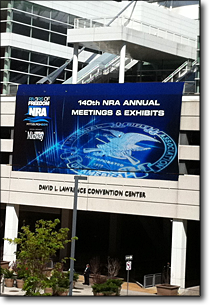
140th NRA Annual Meeting & Exhibits
This year the NRA held its Annual Meeting in Pittsburgh, Pennsylvania April 29 through May 1st and 72,000 people attended. For those that have not attended in the past, I highly recommend you start planning for next year's event.
The NRA AM is the premier event for those interested in firearms. Not only do you get to see products from hundreds of vendors, but you get to meet celebrities, attend seminars, listen to some of our industry and national leaders, and be entertained over the course of a few days.
It is a family event where you can bring the wife and kids, and there are activities for all. From concerts, shooting ranges, seminars, book signings, giveaways and exhibits to the large number of speakers, each member can pick and choose what they want to do, without even touching on the sightseeing opportunities. Due to my busy schedule, each year I look back at all the activities I missed because there is just not enough time in the day.

NRA Annual Meeting 2011 - Show Floor
Products
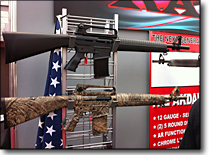
AKDAL MKA 1919 Shotgun
The exhibits at the NRA show include most of the major firearms manufacturers showing off their product lines as well as featuring new products. Among them was the recently imported Akdal MKA 1919.The Akdal MKA 1919 is a gas operated, semi-automatic shotgun created by Turkish company Akdal Arms. It is intended for use by civilian and security markets and is an "AR-15-style" shotgun.
Other "new" products include the Browe Combat Optic: the BCO offers customers a modern designed, internally-adjustable, combat optic with many unique features, such as Single Intuitive Control, Target Light Sensor Technology, field-programmable BCO Micro-controller, and a vibration sensor all packaged in a rugged and versatile titanium housing. The Benjamin Rogue .357 which will be available shortly, Coonan .357 Magnum 1911, Armalite SPR Mod 1, and the very nice Cabot Guns 1911s made in Pittsburgh were all on display.
NRA Displays
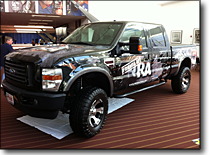
Friends of the NRA F-150 Truck
The various organizations that make up the NRA are well represented, and include information as well as exhibits and events. Among these are the popular NRA Store with hundreds of items on display and for purchase, the NRA-ILA Auction, an NRA Foundation Breakfast, and the popular NRA Country Jam featuring Craig Morgan.
Also represented is the NRA News broadcasting live from the event, the NRA Blog, and booths with information for various NRA programs on education and safety.
Popular at the show was the Pyramid Air Air-Gun Shooting Range where attendees got a chance to shoot a large variety of air guns. Also worth mentioning are the seminars covering a number of topics from sausage preparation to concealed carry and hand-loading; there's something for everyone.
Celebrities
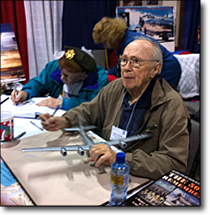
Ted "Dutch" Van Kirk - Last Living Crew Member of the "Enola Gay"
The NRA Annual Meeting has no shortage of celebrities. From the exhibit floor to book signings to the keynote speeches, you're sure to find faces you recognize, championship shooters, and some who are legends you may have never seen before such as the last living member of the "Enola Gay", Ted "Dutch" Van Kirk.
Other faces spotted on the floor included: Ted Nugent, Jessie Abbate, Matt Duff, Matt Hughes, R. Lee Ermey, Michael Bane, Larry Potterfield, Donald Rumsfeld, plus a number of shooting legends like Jerry Miculek, Doug Koenig, Todd Jarrett, Tracy & Lanny Barnes, and many more.
Todd and Jack Hoffman, cast members from Discovery Channel's popular 'Gold Rush' program were in attendance signing autographs and answering questions. Speaking of which there are always a number of models in addition to the celebrities on hand signing posters and calendars.
Keynote Events
Surely the highlight of the weekend is the "Celebration of American Values". Held at the CONSOL Energy Center, where the Stanley Cup Playoffs were being held just a few days before, it featured speakers including Jeff Foxworthy, Mike Huckabee, Michael Reagan, Lt. Col. Oliver North, Wayne LaPierre, Chris Cox, and many others. There is a link at the bottom of this section with videos of most of these speeches, and I highly recommend you watch them.
It is an entertaining yet serious review of our nation's past, present, and future, but it is also a call to arms for all those who believe in keeping our country free, not by trusting others to make the right decisions, but by being an active part of our government. By electing officials that represent our wishes, understand the Constitution, and believe that our great Nation requires constant vigilance or else it can fall to big government, we carry the tradition set forth by our fore-fathers.
For those that argue that the NRA does nothing for them, they owe it to themselves to attend one of these events where they can see and hear all about what the NRA has done, is doing, and will continue to do day in and day out.

NRA Annual Meeting 2011 - View Across River from Convention Center Terrace
Next year the Annual Meeting is in St Louis, MO April 13-15. Hope to see you there!
NRA Videos
|
|
Cory's Corner
|
|
Myths About Gas Piston Systems
By Cory O'Connors
My experience with gas piston systems comes from working for and with Osprey Defense through more than three years of research & development. Working very closely with a group of engineers (you know the ones, the �rocket science type�) that were way smarter than I. The task given to us was to apply the KISS (keep it simple stupid) principle to the gas piston system.
MYTH #1 : CARRIER TILT
In the beginning there was a substantial problem with carrier tilt in most piston systems. To be clear, carrier tilt is when the rear section of the carrier dives into the buffer tube and gouges it severely.
Most of the people posting nowadays saying they have carrier tilt are just showing minor finish wear on the inside of the buffer tube, and panicking thinking they have a carrier tilt issue. This is not an issue and should not be confused with the destructive characteristics of true carrier tilt. Minor wear on the inside of the buffer tube is not uncommon, particularly with the carrier that has �skis�.
Carrier tilt was most prevalent with systems trying to use a bolt-on gas key. Engaging the carrier from the op rod at a position that far forward caused the rear end of the carrier to dive down into the buffer tube causing the severe damage. A large portion of the issue was resolved with the application of solid carriers, which moved the point of engagement rearward. Some manufacturers have chosen to beef up or add "skis" to the rear of the carrier for extra insurance, but there are drawbacks as the extra mass can cause a tight fit and excess drag.
There are still occasions where carrier tilt is experienced on newer systems. Usually, but not always, it can be attributed to a misalignment or improper installation of the buffer tube. It�s generally presumed, however, not always the case, that all uppers and lowers align per mil-spec, but there are many items on the market that do not adhere to the true specifications. Sometimes the solution to this is as simple as adding an Accu-wedge to help align an upper and a lower receiver.
One other potential cause of problems is over gassing a piston system by enlarging the gas hole through the barrel. Typically the enlarged hole was done prior to the gas piston system installation to overcome the shortcomings that may have occurred with the previously installed D.I. gas system.
MYTH #2 : PISTONS ARE LESS ACCURATE THAN D.I.
Once again, early piston systems did not have the technical advantages available to us today. Today we have the ability to test and balance volume and flow of gas entering the piston chamber and its timing to the milliseconds. Not having the proper balance of gasses and trapped volume caused timing issues.
Sometimes pistons would engage the bolt prematurely prior to chamber pressures diminishing, releasing the cartridge from the chamber and causing op rods to bend and cartridge rims to be ripped from cases. Mechanical parts moving prior to the bullet exiting the barrel adversely affected accuracy and reliability. Timing was the key to curing these issues, and most major manufacturers have overcome these issues making the piston driven AR very accurate and reliable.
MYTH #3 : EXTERNAL VALVES ARE BETTER THAN NO VALVES
This one could go either way. External valves are used to adjust the gas allowed into the chamber, which allows use of a wider range of cartridges and suppressed or un-suppressed fire without significant variance in cyclic rate or wear on the receiver. Units without an external valve still need to meter the flow of gas into the piston somehow, and typically the bypass allowed around the piston is to some extent self regulating; the higher the pressure, the more bypass is allowed. Therefore high pressure and low pressure cartridges, suppressed or un-suppressed, the piston exerts similar force against the bolt carrier eliminating the need for manual adjustment.
MYTH #4 : GAS PISTON SYSTEMS EXHIBIT EXCESSIVE HEAT IN THE HAND GUARD AREA
Piston systems do extend more heat into the hand guard area. This is unavoidable due to redirecting the gas from the bolt carrier to the piston located in the forearm, but generally it is not excessive. It is proportionate to the heat removed from the bolt carrier assembly, but this is a small sacrifice for a bolt and carrier that stays significantly cooler and cleaner. Generally speaking, more open forearms such as rails that allow for faster heat dissipation, greatly compliment piston systems.
Cory is the newest member to the AR15.com team. His official title is 'Director of Product Development', but he is also our technical expert. Each month he will answer some of your technical questions and address some of your product ideas here. You can email Cory at [email protected].
|
|
A History of AR Cartridges
|
|
This article is an excerpt from Patrick Sweeney's new Gun Digest Book of the AR-15 Vol. III. Get your copy here.
Military demands and civilian self-defense roles in the world change rapidly, and so must cartridges available for the proven AR platform
By Patrick Sweeney

The original caliber for the AR-15 wasn't the .223/5.56, it was a slightly smaller cartridge. The .222 Special delivered the kind of performance that the designers wanted, which was basically a 50-grain bullet at under 3,000 feet per second.
The Army, trying to keep the AR away and keep the M14 in the running, kept moving the goalposts. Finally, they insisted that the bullet used had to penetrate a steel helmet at a distance farther than their own research had indicated soldiers fired on opponents. The special got stretched and boosted, until the 55-grain FMJ was at 3,100 fps.
And there it stood, until the mid-1980s, when the SS109 came about. That was intended for use against swarms of Soviet infantry in Western Europe. What, there never were swarms of Soviet infantry in Western Europe? Musta worked.
Seriously, the expectation was that the Soviets would roll West, and the NATO allies would be faced with Russian, East German, Polish and who knows who else mechanized infantry piling out of their BMDs, BMPs, and BTRs, lining up and assaulting the NATO positions. They expected to face lots of targets, and not only armed ones, but armored infantry. So, the push was for armor-piercing performance, leading to the SS109 and the later M-855, with a 10-grain steel penetrator tip inside.
The new rifle also received a new barrel twist, one turn in seven inches, to fully stabilize the SS109 and the tracer as well. Only the tracer really needed the new twist, but the military approach was/is a "one size fits all" approach, so there it was. I had a talk with Mark Westrom, CEO of Armalite about that, and he remarked that it would cost more to prove to the Army that a 1:9 twist was better than it would cost to re-barrel every rifle in inventory to 1:9.
Fast-forward to Somalia, the infamous "Blackhawk down" incident. There, good shooters (Rangers, Special Forces and Delta operators) spent a long time, and a lot of ammo, shooting at people who in many instances didn't fall down when hit. To everyone's surprise, small bore ammo designed to penetrate to a fare-thee-well failed to do more than create simple perforation wounds on unarmored opponents.
So the system stayed quiet until we were in another shooting war, and reports came back. This time, they came back too often, and too frequently, and over a long period of time, to be ignored. As a result, the now well-known Mk 262 load was developed. What it does is simple: it takes advantage of the too-fast twist of the M16A2 and M4, the 1:7 twist, and loads a 75- or 77-grain bullet in the case. The longer bullet is less stable than the shorter, 62-grain M855, and thus overturns on impact or soon after.
The next step was a refinement, the Mk 262 Mod 1, which included a cannelure in the bullet. The cannelure is a place to crimp the case neck into, but it also strategically weakens the bullet. When it begins to overturn on impact, it then breaks apart at the cannelure.
Stop wringing your hands. Lots of bullets overturn, tumble in the parlance, and lots of bullets have cannelures. And some have both, such as the old loading, the M-193, the 55-grain load from the Vietnam era.
The Mk 262 carries its speed better and offers longer-range performance. In fact, it offers too much long range performance, at least as far as hitting is concerned. You see, it puts the Army on the horns of a dilemma. The load is so accurate in some rifles that a skilled shooter can hit his target far beyond the effective ballistic "thump" of the bullet. Yes, a 77-grain bullet is gonna hurt, but when it has dropped to the performance of a .22 rimfire magnum, it gets tough to justify it.
What's worse, not all (in fact, very few) of the soldiers who might get their hands on it can actually make use of its range. Yes, I'd rather poke a .224 hole through a bad guy at 700 yards, than let him walk off unscratched. The awful truth is, the Army doesn't teach enough about marksmanship to let soldiers do that. The qualification course goes out to 300 meters.
There is no feedback, so if you nick the edge of the target you get scored the same as if you center-punched every one. Beyond 300 meters is a mystery, and many soldiers will be told to not shoot at the 300-meter targets, to save the rounds. That way, they can use the extras to make sure they get this close in. After all, with 20 targets coming up, and 20 rounds, you need only a dozen hits to pass. So, if the far targets are chancy, save your shots for the sure thing.
Which is a less than reassuring skill set to have, wedged behind a boulder in Afghanistan whilst being thrashed by a tripod-mounted PKM from 800 meters out.
No, the Army spends time teaching marksmanship skills to only a very few. They haven't time, being too busy with a whole raft of mandated courses they have to teach first. But that doesn't keep shooters from dreaming. The first dream was to stretch the existing round more. The longest-lasting and most-desired is to go back to the very beginning.
The 6x45 is a way to get heavy hunting bullets (or light varmint grenades) into a .223 case. If your state doesn't allow .22s for hunting, this is your caliber.
6x45
One of the first wildcats for the AR, and other rifles, it is a simple one to effect: basically take a .223 case with a neck not work-hardened too much and pop a 6mm neck expander stem through it. The result is a .223/5.56 case with a neck that will hold a .243-inch bullet instead of a .224-inch bullet.
As a deer-hunting round, this offers some prospects. In a bolt-action rifle, unless it is one scaled for the .223 and the .223 alone, you can gain useful case capacity by loading the bullet longer. The longer-loaded bullet doesn't protrude into the case, and you end up with as much capacity as the .223 had.
However, we have not that luxury in the AR-15. The magazine dictates just how much length we have to work with, and no more. That, combined with the fixed location of the case mouth, means we cannot use a longer, more aerodynamic bullet to keep the speed up downrange. It also limits the weight we can use, as a heavier bullet decreases case capacity (the room for powder) and thus gives us a double whammy in velocity loss: more weight and less powder.
However, improved powders have changed that somewhat since the 1960s, the last time anyone looked at the 6x45 in rifles.
The modern look is interesting, as it combines with the sudden increase in the AR, with a mild deer-capable cartridge. There are states that do not allow .22 rifles for deer hunting. However, a 6mm such as the 6x45 is allowed. So, a 6mm loaded with soft point bullets, say an 80-grain bullet at 2,800, is plenty good enough to drop a whitetail.
Now, since we can't always depend on the velocity printed on the box, and a lot of ARs for hunting would be handier, in a 16-inch-barreled carbine, we'd be talking more like 2,650, but that is still good enough to drop any whitetail who ever walked the American continent, given a well-placed shot.
The 6x45 has been around since at least 1965 as a recognized wildcat. In all that time, it didn't get much traction. Why does it now? Two things: new powders and new bullets. In 1965, if you could push an 85-grain bullet much past 2600 fps, you were doing great. And the bullet so-pushed was a plain old "cup and core" soft point, with not much ability to retain weight or shape and penetration.
Now, we have powders that can push the same weight at 2800 fps, a more useful velocity. And the bullets being pushed, bonded-core soft points, all-copper hollow points, will retain weight, penetrate and work like they are much bigger bullets than they are. At the other extreme, varmint bullets are much better than they were in 1965. They are more accurate, fragile, and able to be pushed to higher velocities. If you want warp speed, a Hornady VMax of 58 grains loaded to 2950 fps is your choice, and if you want a bit more range even if it means giving up 75 fps, then their 65-grain VMax at 2875 fps will vaporize varmints at distance.
All of which makes the 6x45 a much more attractive hunting/varmint cartridge than it used to be. However, there are some touting it as a replacement for the 5.56 as a defensive load. There, I have to part company with them. The 6x45 as a deer cartridge works well because of the new generation of expanding bullets. In a military context, expanding bullets aren't allowed. Yes, police and non-sworn taxpayers can use expanding bullets, but the fewer offerings in the 6x45 make it less useful. I know, I know, it's like the getting-your-first-job conundrum: You have to have experience to get a job, but if you haven't had a job, how are you going to get experience?
If people don't buy the 6x45 for defense, how can they expect the ammo makers to load defensive ammo for it? Not my problem.
The 5.56 gets around the "no expanding bullets" problem by using long-for-their-weight bullets that tumble and break. The 6x45 is boxed in in that regard. Any bullet you can push fast enough to break up is too short to be broken. And any bullet long enough to be breakable is too heavy to push to a speed where it breaks.
The pilots among us will talk of the "performance envelope" which is a graph of speed and altitude, turning radius, range, etc. Operating "in the corner" or "on the edge" means going right up to the limit. The U-2 worked that way. It traveled so high, where the air was so thin, and so close to the limits of its ability, that pilots could not make turns that were too tight. To do so would mean the wingtip of the inside wing (the wings were very long for its size) would slow down, and fall below the stall speed of the aircraft. The sudden drag of the stalling wingtip would put the U-2 in a flat spin, which was usually not something the pilot could recover from.
The 5.56 is operating in a corner of its performance envelope: there is just enough room to push a 75- or 77-grain bullet fast enough to make it break up when it tumbles. The 6x45 does not have that room.
So for the military it isn't a viable option. But for hunters and the non-military defensive user, it offers many advantages. And the biggest of those is that to convert a rifle to 6x45, you need only a new barrel. The bolt and magazines of your 5.56 will work just fine, thank you very much.
Read the Rest of this Article on TacticalGearMag.com
|
|
3-Gun News
|
|
Upchurch Maintains 3GN Points Lead
By Chad Adams

Clint Upchurch's fourth consecutive Open division victory kept the South Carolina native alone in first place atop the 3GN Standings following the recent Blue Ridge Mountain 3-Gun at the Rockcastle Shooting Center. But staying in first by himself might not last too long.
Daniel Horner picked up his third match at Blue Ridge, with his Tactical Optics win vaulting the defending 3GN Champion up the leader board into second place.
Kurt Miller, who did not compete at Blue Ridge, remained in the top five at third, while SureFire's Barry Dueck switched to Heavy Metal for a win, moving him to fourth place in front of Bryan Ray, who fell to fifth overall following his second place finish to Dueck in Heavy Metal at Blue Ridge.
Taran Butler, James Darst, Jeff Cramblit, Robby Johnson and Tony Holmes round out a top 10 that features two competitors that didn't qualify for last year's 3GN Championship: Remington's Robby Johnson, who didn't attend enough matches last season; and Ray, the non-sponsored shooter who seemingly came out of nowhere last year and is now tearing up the Heavy Metal division.
Five ladies currently sit among the 3GN Top 50. At #30 overall, Kay Miculek holds the top Lady spot, followed by Maggie Reese (#36), Katie Harris (#41, who is also 3GN's top Junior), Dianna Liedorff (#43) and Deb Cheek(#45).
In the 3-Gun Nation Divisional Championships race, with $25,000 on the line from Hornady, competitors have been jockeying for position, and a few have even jumped divisions. Each of the five 3GN divisions has a $5,000 cash prize up for grabs, totaling $25K for the season. But with six points events remaining, there is still a lot of shooting to be done, with arguably the toughest event in the sport looming - the MGM Ironman.
Daniel Horner used his division win at the Blue Ridge Mountain 3-Gun to rocket himself up the Tactical Optics leader board, overtaking Taran Butler, now in second. Robby Johnson's second place Blue Ridge finish moved Horner's former AMU teammate into third place, followed by Rob Romero and Rustin Bernskoetter.
MGM's Travis Gibson continued his steady improvement, earning a spot in sixth place in Tactical Optics, followed by Ben Fortin, Tyler Payne, Scott McGregor and Jamie Foote.
In Open, everyone is chasing Clint Upchurch, who's second year of competitive 3-gun has become a complete breakout performance.
James Darts sits in second, followed by FN's Tommy Thacker, Brian Butcher and Kay Miculek. Notable Open absences are Jerry Miculek and Mike Voigt, who when they pick up their third matches are expected to shake up the Open standings.
In Heavy Metal Optics, one man stands alone. SureFire's Barry Dueck is currently the only qualified competitor with a strong score of 292.03. However, Adam Popplewell is expected to challenge Dueck for the title.
In Tactical Irons (Limited), only two competitors currently have enough scores, with Kurt Miller holding a commanding lead over Brian Vaught, a non-sponsored shooter from Kentucky. However, Kelly Neal is expected to shake things up when he picks up his third match.
Vaught's training partner, and brother-in-law, Bryan Ray, tops the Heavy Metal race, one that is shaking up to be very interesting coming down the stretch. With Ray not expected to attend every match, JJ Johnson and Trapr Swonson, sitting second and third, respectively, along with Joe Satterfield, should have opportunities to pick up division wins without having to be Ray. That alone could set Heavy Metal up for a photo finish at the FNH USA Championships in November.
The next event on the FNH USA 3-Gun Nation Tour, Presented by SureFire, is the MGM Ironman, June 5-11, in Parma, Idaho. Along with 3GN points, the Ironman will also host a 3-Gun Nation Shoot-Off, with the winner taking home a $5K prize from Warne Scope Mounts.

|
|
Direct Action
|
|
Winning the Future
By Joe DeBergalis (DirectAction)

May is a month filled with celebrations. Many a ARFCOM Member is either readying themselves for graduation or preparing to celebrate the graduation of their own children from a variety of school programs. As your ARFCOM-endorsed NRA Board Member, let me be among the first to offer my personal best wishes to everyone wearing a "cap and gown" this month.
To ensure that we all have a bright future - I would like to call to your attention a variety of scholarship opportunities available from the NRA. These programs not only help our children grow educationally into future leaders, but also foster the values we seek in the new generation of Second Amendment Defenders.
One such NRA program is the annual NRA Youth Education Summit (Y.E.S.). Open to all high school sophomores and juniors with at least a 3.0 grade point average, Y.E.S. is an event hosting some of the best and brightest young people from all over the country in the nation's Capitol to teach participants the importance of the U.S. Constitution and participation in the political process.
Founded in 1996 with generous donations from Friends of NRA events, Y.E.S. is a week-long expense-paid educational trip through Washington, D.C. and the surrounding area. Stops include the U.S. Capitol, the Pentagon, the National Archives, and the NRA headquarters, home to the National Firearms Museum and a world-class indoor shooting range, where the students get a chance to hone their skills.
More than just sightseeing, the students also participate and compete in a series of academic events that include public speaking exercises and debates. Students have good reason to study in anticipation of these events and to work hard throughout their Y.E.S. experience, as at the end of the program, $10,000 in scholarships are awarded to students who excel in the performance of these activities. Students are also encouraged to put to use the skills they learn during the summit, as Y.E.S. participants are eligible for an additional $20,000 in scholarships awarded to those students who work to promote NRA programs in their community in the months following their trip.
Another way in which NRA is helping to shape the future leaders of America is through the annual NRA Civil Rights Defense Fund Youth Essay Contest. Participants are asked to provide a 1,000 word essay on the theme, "The Second Amendment to the Constitution: Why it is important to our nation." Like any essay a student writes for school, their work will be graded on presentation and scholarship. However, students submitting essays to the NRA are also encouraged to explore new ideas, with originality being a grading criterion.
Different from Y.E.S., the NRA Civil Rights Defense Fund Essay Contest is judged in two categories, allowing for the participation of younger students. Separate scholarships totaling $3800 are offered to those contestants in grades 10-12 and those in grades 9 and below.
I encourage ARFCOM members with high school age young adults to offer them the opportunity to apply for Y.E.S. and to enter the NRA Civil Rights Defense Fund Essay Contest.
Finally, the NRA proudly recognizes the service of our nation's law enforcement officers through the Jeanne E. Bray Memorial Scholarships Awards Program, which awards up to $1,000 per semester to dependent children of NRA members who are current or retired law enforcement officers. Scholarships are also awarded to children of law enforcement officers killed in the line of duty, who were NRA members at the time of death, or to children of law enforcement officers who are NRA members and who were disabled in the line of duty.
As with all of NRA's programs, all of these contests and scholarships rely on the generosity of NRA members. Supporting NRA programs that engage the youth of America is an important way in which gun rights supporters can help win a future for private gun ownership for generations to come. To learn more about participating in or donating to these important programs, visit: NRA Youth Education Summit, Writing Contests & Scholarships and LE Benefits from the NRA.
|
|
|


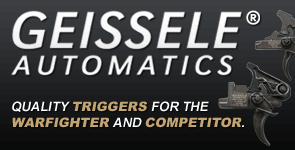
ADVERTISE HERE
   
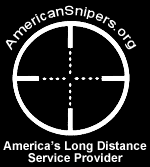


|
|



 FORUMS
FORUMS
 STORE
STORE
 EQUIPMENT EXCHANGE
EQUIPMENT EXCHANGE
 INDUSTRY FORUMS
INDUSTRY FORUMS
